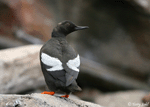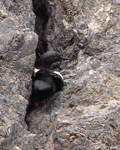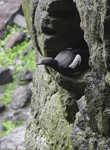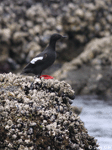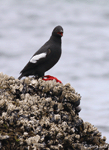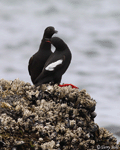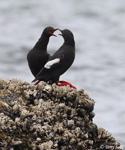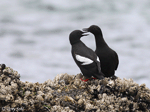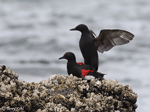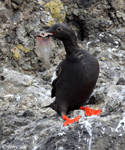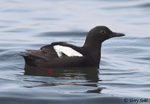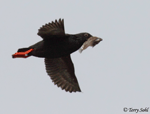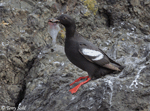| Length: 13 inches | Wingspan: 24 inches | Seasonality: Non-resident in South Dakota |
| ID Keys: In breeding plumage, black overall with white wing bar, bright red feet, red inner mouth. In winter, mottled black and white above, white below. | ||
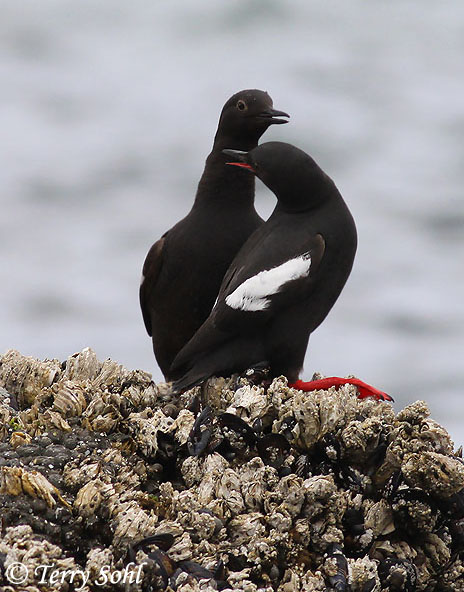 The
Pigeon Guillemot is a auk speices found on the Pacific Coast of much of
North America. At first glance during the summer breeding season, they
appear to be an elegant mix of black and white, but a better view provides a
glimpse of strikingly bright red legs, and a bright red lining inside the
mouth during the breeding season. In winter, the plumage is much more
muted, a mottled mix of blacks, whites, and grays. Mated pairs typically
stay together for multiple years, and also will use the same nest sites year
after year.
The
Pigeon Guillemot is a auk speices found on the Pacific Coast of much of
North America. At first glance during the summer breeding season, they
appear to be an elegant mix of black and white, but a better view provides a
glimpse of strikingly bright red legs, and a bright red lining inside the
mouth during the breeding season. In winter, the plumage is much more
muted, a mottled mix of blacks, whites, and grays. Mated pairs typically
stay together for multiple years, and also will use the same nest sites year
after year.
Habitat: During the summer breeding season, they are found on rocky coastlines, cliffs, or rocky islands. At other seasons, they are at sea, but are typically relatively close to shore or the edge of pack ice in winter.
Diet: Feeds on a variety of marine life. Diet may include small fish, mollusks, marine worms, small crustaceans, jellyfish, small starfish, and other small ocean creatures.
Behavior: Forages by swimming on the water's surface and then diving and swimming under waer in search of prey. They can dive to depths of up to 150 feet while foraging.
Nesting: The nest of a Pigeon Guillemot is either in a crack amongst large rocks, or in a burrow. They will either use and modify an existing burrow built by another animal, or wiill dig their own. The nest itself is a simple scrape with gathered pebbles and seashells. Both the parents incubate the eggs, and both parents feed and tend to the young upon hatching.
Song: On their breeding grounds, they have a very high-pitched whistling, as well as a staccato series of notes that rise in pitch and accelerate before slowing towards the end.
Migration: Birds at the far northern edge of their range on the west coast of Alaska do move southward to the edge of the winter's pack ice. However, most birds do appear to be permanent residents.
Interactive eBird Map: Click here to access an interactive eBird map of Pigeon Guillemot sightings
Similar Species: Black Guillemot. The two species are very similar in appearance. Note in the photo above, the Pigeon Guillemot shows a black bar crossing/interrupting the white wing patch on breeding birds. On the Black Guillemot, the white wing patch is much "cleaner", without the dark feathers crossing it at the bottom.
Conservation Status: Population trends appear to be stable, and the geographic range of the species is large. The IUCN currently lists the Pigeon Guillemot as a species of "Least Concern".
Further Information: 1) BirdWeb.org - Pigeon Guillemot
2) WhatBird - Pigeon Guillemot
3) Audubon Guide - Pigeon Guillemot
Photo Information: Photo taken on June 8th, 2009 - Haystack Rock, at Cannon Beach, Oregon - Terry Sohl
| Click below for a higher-resolution map |
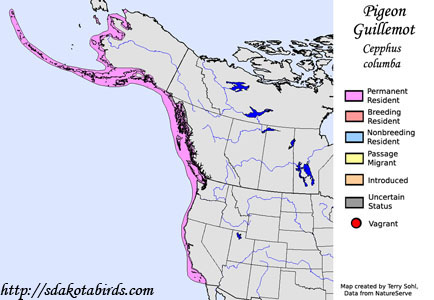 |
| South Dakota Status: Non-resident in South Dakota |
Additional Pigeon Guillemot Photos
Click for a higher-resolution version of these photos
